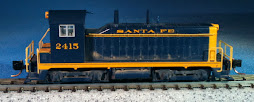Here are my suggestions to kick off the discussion ...
- Command Station: Digitrax DCS100 5amp
- Booster: Digitrax DB150
- Power Supplies: DCC Specialties Magna Force MF615
- Circuit Protection: DCC Specialties PSX Series (1, 2, 3, & 4 sub-districts)
- Wireless Interface: Digitrax UR-92 (duplex radio)
- Throttle: Digitrax DT402D (wireless/duplex radio)
- PC Interface: Digitrax PS-3
- Occupancy Detection: Digitrax BDL168
- Turnout Control: Digitrax DS-64 -OR- Team Digital SRC16
- Signal Control: Digitrax SE8C
Come on guys, let's get a good discussion started with the comments to this post ...
Richard




